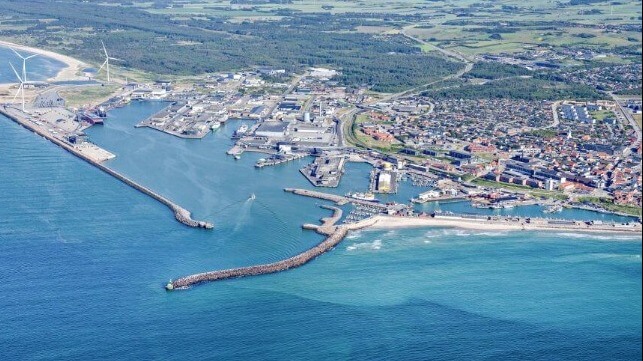Shipping Hub to Be Launched in Danish Hirtshals Port for CCS Project

A consortium of Scandinavia companies is launching an effort to establish a Danish hub for the export of CO2 produced while manufacturing biogas as part of a pioneering project for the storage of CO2 using wells reaching the sandstone below the seafloor. The Greenport Scandinavia project is designed to support the CCS Project Greensand, which received its license this week as Denmark’s first carbon storage program. The project is preparing for a pilot program of injections of CO2 for storage by early 2023 and expects to be operating at scale by 2025.
Under the agreement announced at the beginning of December, seven companies including those involved in the production of biogas will participate in the project for the transport and storage of biogenic CO2 in North Jutland. The partners will initially transport retained CO2 from local biogas plants to the port of Hirtshals in northern Denmark, from where it is shipped out for storage in empty oil fields in the North Sea as part of the CCS Project Greensand.
The collaboration also involves investigating the possibilities for establishing Europe's largest CO2 hub at the port of Hirtshals. Among the elements that will be investigated is the possibility of establishing the necessary infrastructure in the form of, for example, pipelines for the transport of CO2 from Denmark and other parts of Europe to Hirtshals.
“We are already working purposefully with plans for the expansion of the port of Hirtshals, and in this connection, the storage and shipping of CO2 to the North Sea fits perfectly into our strategy,” said Per Holm Nørgaard, CEO of the Port of Hirtshals. “In the long term, the establishment of a CO2 hub in Hirtshals can contribute to solving the climate challenges, and we see great potential in the cooperation we have entered with the other partners.”
The project, which is reported to be the first of its kind in Denmark, also has the potential to achieve negative emissions across the broader CCS value chain. The companies point out they would be capturing the CO2 during the production of biogas made in part from liquid manure from livestock farms, reducing emissions and resulting in a product that also lowers emissions for shipping and other industries.
Under the plan for Greenport Scandinavia, the companies which include INEOS Energy, Wintershall DEA, Port of Hirtshals, Biocarb Solution, Evida, Blue Water Shipping, and Greenport North, plan to establish temporary storage facilities at the port of Hirtshals. This would enable shipping to the North Sea, where the CO2 is pumped underground. Initially, the goal is to capture up to 100,000 tons of biogenic CO2 annually from North Jutland biogas plants as early as 2024/2025. The CO2 will be transported to the port of Hirtshals and by ship to the Siri area in the Danish part of the North Sea, where it is stored in empty oil fields through the Greensand project.
Project Greensand, which is supported by the Danish state through the Energy Technology Development and Demonstration Program (EUDP), received the first permit for CCS. It permits them to conduct a trial program over a four-month period through April 1, 2023, to inject up to 15,000 tons of CO2 in the former Nini West oil field. This pilot phase will help develop the storage process as well as test, demonstrate, and monitor the operation. Work is underway to prepare an offshore supply vessel and a jack-up rig for the first injection tests of CO2 starting around the end of this year or in early 2023.
Over the next three years, they plan to extend the storage area to provide a capacity of 1.5 million tons of CO2 annually. The CO2 will be transported on special ships to the former offshore oil field in the Danish part of the North Sea. Starting in 2030 they expect to have the capacity to handle 8 million tons of CO2 per year. The liquid CO2 will be sent down into the sandstone reservoir more than one mile underground via CO2 wells.
